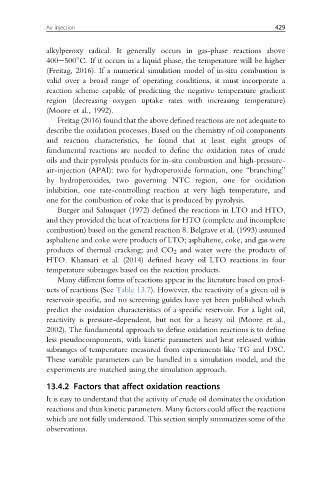Page 462 - Enhanced Oil Recovery in Shale and Tight Reservoirs
P. 462
Air injection 429
alkylperoxy radical. It generally occurs in gas-phase reactions above
400e500 C. If it occurs in a liquid phase, the temperature will be higher
(Freitag, 2016). If a numerical simulation model of in-situ combustion is
valid over a broad range of operating conditions, it must incorporate a
reaction scheme capable of predicting the negative temperature gradient
region (decreasing oxygen uptake rates with increasing temperature)
(Moore et al., 1992).
Freitag (2016) found that the above defined reactions are not adequate to
describe the oxidation processes. Based on the chemistry of oil components
and reaction characteristics, he found that at least eight groups of
fundamental reactions are needed to define the oxidation rates of crude
oils and their pyrolysis products for in-situ combustion and high-pressure-
air-injection (APAI): two for hydroperoxide formation, one “branching”
by hydroperoxides, two governing NTC region, one for oxidation
inhibition, one rate-controlling reaction at very high temperature, and
one for the combustion of coke that is produced by pyrolysis.
Burger and Sahuquet (1972) defined the reactions in LTO and HTO,
and they provided the heat of reactions for HTO (complete and incomplete
combustion) based on the general reaction 8. Belgrave et al. (1993) assumed
asphaltene and coke were products of LTO; asphaltene, coke, and gas were
products of thermal cracking; and CO 2 and water were the products of
HTO. Khansari et al. (2014) defined heavy oil LTO reactions in four
temperature subranges based on the reaction products.
Many different forms of reactions appear in the literature based on prod-
ucts of reactions (See Table 13.7). However, the reactivity of a given oil is
reservoir specific, and no screening guides have yet been published which
predict the oxidation characteristics of a specific reservoir. For a light oil,
reactivity is pressure-dependent, but not for a heavy oil (Moore et al.,
2002). The fundamental approach to define oxidation reactions is to define
less pseudocomponents, with kinetic parameters and heat released within
subranges of temperature measured from experiments like TG and DSC.
These variable parameters can be handled in a simulation model, and the
experiments are matched using the simulation approach.
13.4.2 Factors that affect oxidation reactions
It is easy to understand that the activity of crude oil dominates the oxidation
reactions and thus kinetic parameters. Many factors could affect the reactions
which are not fully understood. This section simply summarizes some of the
observations.

